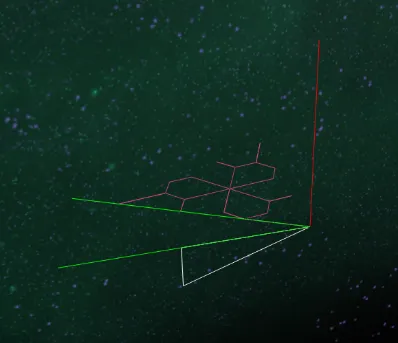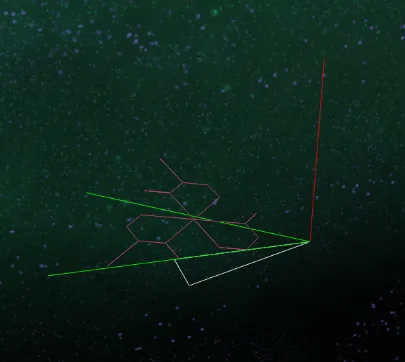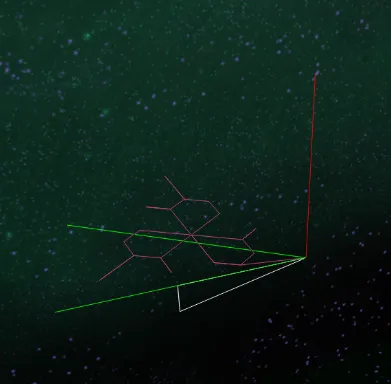我有一系列顶点(粉色)需要旋转,以便顶点的一条边与三角形的边缘(白色)匹配。
首先,我创建两个向量 floretAB 和 triangleAB(绿色)来表示这两个边。然后,我找到这两个向量的叉积,得到一个绕着它们旋转的轴(红色)。
接下来,我计算这两个向量之间的夹角,并使用该夹角和旋转轴创建四元数。最后,我将所有顶点绕着该四元数旋转。

旋转前
_

旋转后效果
_
但是,虽然旋转后的顶点正确绕着四元数旋转了,但夹角没有正确计算,如图所示:

以下是我用于计算两个向量之间夹角的代码。我不明白自己做错了什么:
double[] cross = new double[3];
crossProduct(floretAB.mX, floretAB.mY, floretAB.mZ, triangleAB.mX, triangleAB.mY, triangleAB.mZ, cross);
double dot = dotProduct(floretAB.mX, floretAB.mY, floretAB.mZ, triangleAB.mX, triangleAB.mY, triangleAB.mZ);
double crossMag = Math.sqrt(cross[0]*cross[0] + cross[1]*cross[1] + cross[2]*cross[2]);
double angle = Math.atan2(crossMag, dot);
public static double dotProduct(double vector1X,double vector1Y,double vector1Z,double vector2X,double vector2Y,double vector2Z){
return vector1X*vector2X + vector1Y*vector2Y + vector1Z*vector2Z;
}
public static void crossProduct(double vector1X,double vector1Y,double vector1Z,double vector2X,double vector2Y,double vector2Z, double[] outputArray){
outputArray[0] = vector1Y*vector2Z - vector1Z*vector2Y;
outputArray[1] = vector1Z*vector2X - vector1X*vector2Z;
outputArray[2] = vector1X*vector2Y - vector1Y*vector2X;
}
任何帮助都将不胜感激,因为这个问题真的让我很烦恼。谢谢,詹姆斯。
编辑:以下是代码的其余部分:
// get floret p1,p2 vector
// get triangle p1,p2 vector
Vector3D floretAB = new Vector3D(florets3D[0], florets3D[7]);
// get triangle p1,p2 vector
Vector3D triangleAB = new Vector3D(triangle[0], triangle[1]);
// get rotation axis (cross) and angle (dot)
/*
double[] cross = new double[3];
crossProduct(floretAB.mX, floretAB.mY, floretAB.mZ, triangleAB.mX, triangleAB.mY, triangleAB.mZ, cross);
double dotMag = floretAB.getMagnitude() * triangleAB.getMagnitude();
double dot = dotProduct(floretAB.mX, floretAB.mY, floretAB.mZ, triangleAB.mX, triangleAB.mY, triangleAB.mZ) / dotMag;
double angle = Math.acos(dot);
*/
double[] cross = new double[3];
crossProduct(floretAB.mX, floretAB.mY, floretAB.mZ, triangleAB.mX, triangleAB.mY, triangleAB.mZ, cross);
double dot = dotProduct(floretAB.mX, floretAB.mY, floretAB.mZ, triangleAB.mX, triangleAB.mY, triangleAB.mZ);
double crossMag = Math.sqrt(cross[0]*cross[0] + cross[1]*cross[1] + cross[2]*cross[2]);
double angle = Math.atan2(crossMag, dot);
// rotate floret so p1,p2 vector matches with triangle p1,p2 vector
double[] newVerts = new double[3];
Quaternion quat = new Quaternion(cross[0], cross[1], cross[2], angle);
for(int i = 0;i<numfloretVerts;i++){
Vertex3D vert = florets3D[i];
quat.RotateVector(vert.getmX(), vert.getmY(), vert.getmZ(), newVerts);
vert.setmX(newVerts[0]);
vert.setmY(newVerts[1]);
vert.setmZ(newVerts[2]);
}
_
public class Vector3D {
public double mX;
public double mY;
public double mZ;
public Vertex3D point;
/**
* Constructs a vector from two points. The new vector is normalised
*
* @param point1
* @param point2
*/
public Vector3D(Vertex3D point1, Vertex3D point2){
mX = point2.getmX() - point1.getmX();
mY = point2.getmY() - point1.getmY();
mZ = point2.getmZ() - point1.getmZ();
normalise();
point = point1;
}
/**
* Normalises the vector
*/
public void normalise(){
double magnitude = Math.sqrt(mX*mX + mY*mY + mZ*mZ);
if(magnitude!=0){
mX /= magnitude;
mY /= magnitude;
mZ /= magnitude;
}
}
/**
*
* @return the magnitude of the vector
*/
public double getMagnitude(){
return Math.sqrt(mX*mX + mY*mY + mZ*mZ);
}
}
_
public class Quaternion {
private static final double TOLERANCE = 0.00001f;
double w;
double x;
double y;
double z;
public Quaternion(double axisX, double axisY, double axisZ, double angleInRadians){
setAxisAngle(axisX, axisY, axisZ, angleInRadians);
}
public void Normalise(){
// Don't normalize if we don't have to
double mag2 = w * w + x * x + y * y + z * z;
if (Math.abs(mag2) > TOLERANCE && Math.abs(mag2 - 1.0f) > TOLERANCE) {
double mag = (double) Math.sqrt(mag2);
w /= mag;
x /= mag;
y /= mag;
z /= mag;
}
}
public void getConjugate(double[] outputArray){
outputArray[0] = w;
outputArray[1] = -x;
outputArray[2] = -y;
outputArray[3] = -z;
}
public void Multiply(double[] aq, double[] rq, double[] outputArray){
outputArray[0] = aq[0] * rq[0] - aq[1] * rq[1] - aq[2] * rq[2] - aq[3] * rq[3];
outputArray[1] = aq[0] * rq[1] + aq[1] * rq[0] + aq[2] * rq[3] - aq[3] * rq[2];
outputArray[2] = aq[0] * rq[2] + aq[2] * rq[0] + aq[3] * rq[1] - aq[1] * rq[3];
outputArray[3] = aq[0] * rq[3] + aq[3] * rq[0] + aq[1] * rq[2] - aq[2] * rq[1];
}
private double[] vecQuat = new double[4];
private double[] resQuat = new double[4];
private double[] thisQuat = new double[4];
private double[] conj = new double[4];
/**
* Rotates a vector (or point) around this axis-angle
*
* @param vectorX the x component of the vector (or point)
* @param vectorY the y component of the vector (or point)
* @param vectorZ the z component of the vector (or point)
* @param outputArray the array in which the results will be stored
*/
public void RotateVector(double vectorX, double vectorY, double vectorZ, double[] outputArray){
vecQuat[0] = 0.0f;
vecQuat[1] = vectorX;
vecQuat[2] = vectorY;
vecQuat[3] = vectorZ;
thisQuat[0] = w;
thisQuat[1] = x;
thisQuat[2] = y;
thisQuat[3] = z;
getConjugate(conj);
Multiply(vecQuat,conj,resQuat);
Multiply(thisQuat,resQuat,vecQuat);
outputArray[0] = vecQuat[1];
outputArray[1] = vecQuat[2];
outputArray[2] = vecQuat[3];
}
/**
* set Quaternion by providing axis-angle form
*/
public void setAxisAngle(double axisX, double axisY, double axisZ, double angleInRadians){
w = (double) Math.cos( angleInRadians/2);
x = (double) (axisX * Math.sin( angleInRadians/2 ));
y = (double) (axisY * Math.sin( angleInRadians/2 ));
z = (double) (axisZ * Math.sin( angleInRadians/2 ));
Normalise();
}
}
Math.atan2(dot, crossMag);- John Dvorak